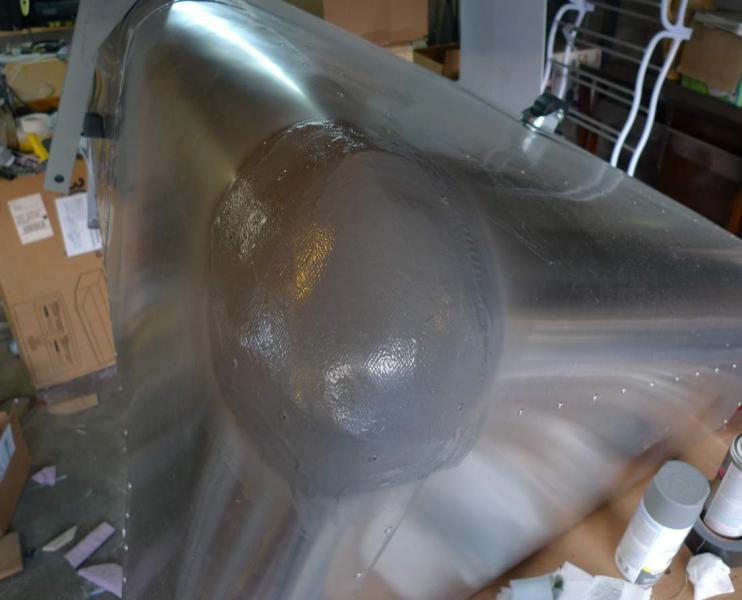How-to make tough fiberglass corners on the aluminum skin base:
Press a section of 2" pink foam against the corner, trace it, and saw it out. Keep sanding until it plugs in from the inside. Apply 5-minute epoxy putty (Kwiksteel) to hold it in place. Need to work the putty a bit to get it to adhere to the rough foam surface.

Sand it to the right form from the outside.

Several steps in the next photo:
- Materials: "Parks Super Glaze" is basically an epoxy resin. Rust-Oleum Parks 1-Qt. Finish and Preservative-241352 at The Home Depot A non-zero number of surfboard builders have used a similar type of product as an epoxy resin (How to Build Your First Surfboard). My attraction to the "Parks Super Glaze" is that it can be found at Home Depot and thus can be obtained in a few minutes, and it is less than twice as expensive per quart as mail-ordering 2 quarts of Klear Kote. To make light-weight low-fume paste, I'm filling my own epoxy using microballoons (by Alumilite Amazon.com: 32oz Microballoons: Toys & Games). Finding microballoons on Amazon Prime meant I could get them within 48 hours with free shipping. Microballoons are hollow glass spheres that are so small that they have the consistency of powdered sugar. As far as fillers go, they are very light and produce a strong sandable paste. (This was more important for the lid than for the corners, I'll come back to that.) Sawdust might have worked just fine for this. I wore a very good filtering mask (my Techno Respro smog mask) while working with the microballoons. Mixing them with epoxy resin is a lot like mixing flour with eggs, and I just keep adding microballoons until I got the consistency of peanut butter, such that the paste could stand up on a vertical surface. I decided to scalp my fiberglass welding blanket for a few lay-ups, it was only $24 (or $0.66/sqft) IIRC and seems to be about a 2-oz weight (unless I'm confused about glass cloth weights, I think it means weight of the cloth per sqft, I weighed a section of my cloth on a kitchen scale). I've had good luck using wet paper towels as a formable welding blanket anyways, whenever I really need it.
- After sanding the foam, I formed some microballoon putty with a plastic paint scraper to fill gaps. (>8 hr cure cycle.)
- Used my epoxy 'resin' to layup my 'glass cloth' over the corner. Because of the viscosity of the epoxy and the weight (and maybe weave) of the cloth, it helps to apply the epoxy under and over the cloth. (>8 hour cure cycle.)

- Sand with 80-grit.
- Drill 1/8" holes for rivets.
- Add another layer of microballoon putty, like a gel-coat (just because I didn't prepare for a gel-coat and I don't like the fumes of the Bondo Body Filler I have on the shelf). I'm becoming rather averse to solvent fumes, if I do fiberglass again it will be 100% epoxy based, no matter what.
- Add rivets while putty is wet. Putty flows enough to mate with rivet head and distribute force from head, making the rivets as strong as possible.

- (>8 hour cure cycle.) Sand with 80-grit.
- Paint.

=========================================
Having already completed both corners, I thought of a better way to form foam corners:
- Tape cardboard to the inside, plus wherever needed outside.
- Apply pour-foam. (Cure.)
- Sand.
This is all assuming that the sheets are not formed evenly enough to use a generic spherical surface, like a barbeque lid. Maybe Phil (Aerohead) measures his metal sheets twice and cuts once?

(Or assembles in a different order.) My methods are for working with imperfections, where the corner is the last step and over-constraining with a true sphere might cause trouble.